Rick Just's Blog, page 194
June 28, 2019
"Dandy Lion" Wine
Four years before the national prohibition of liquor, Idaho became a prohibition state on January 1, 1916. The Idaho Statesman seemed to treat it with good humor, lamenting that it "Would deprive many men of the only home they ever had." (See image)
But there also seemed an element in the paper, as there was in society in general, that had mixed opinions about it. On May 19, 1916, the Statesman reported on an alarming increase in dandelion wine in Boise: "Many owners of dandelion infested lawns have marveled lately at the number of children and grownups who asked permission to help extricate the little golden nuisances 'for a medicine that mother makes,' and have been enthusiastically granted permission.
"It has now earned the manufacture of dandelion wine has been carried on in many Boise homes in large quantities this spring."
State Chemist Jackson (no first name given) tested some of mamma's medicine and found it came in at 12.6 percent alcohol. He opined that perhaps it should be called "Dandy Lion" wine, because of its alcohol content.
The newspaper extolled the wine's virtues as a liver medicine, but cautioned that "many a strict prohibition mother is probably making the wine, never dreaming that she is a lawbreaker."
With those warnings out of the way, the paper proceeded to go give a complete recipe for making the wine.
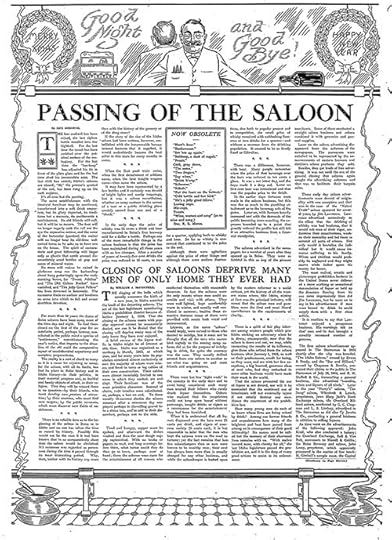
But there also seemed an element in the paper, as there was in society in general, that had mixed opinions about it. On May 19, 1916, the Statesman reported on an alarming increase in dandelion wine in Boise: "Many owners of dandelion infested lawns have marveled lately at the number of children and grownups who asked permission to help extricate the little golden nuisances 'for a medicine that mother makes,' and have been enthusiastically granted permission.
"It has now earned the manufacture of dandelion wine has been carried on in many Boise homes in large quantities this spring."
State Chemist Jackson (no first name given) tested some of mamma's medicine and found it came in at 12.6 percent alcohol. He opined that perhaps it should be called "Dandy Lion" wine, because of its alcohol content.
The newspaper extolled the wine's virtues as a liver medicine, but cautioned that "many a strict prohibition mother is probably making the wine, never dreaming that she is a lawbreaker."
With those warnings out of the way, the paper proceeded to go give a complete recipe for making the wine.

Published on June 28, 2019 04:00
June 27, 2019
Circus Tragedy
I often stagger down the halls of history, careening off the walls and sometimes stumbling into a cobweb-filled room that has been long forgotten. Such was the case recently when I tried to match up a cool photo of a circus parade in Blackfoot with a story from contemporaneous newspapers. It turned out there wasn’t much more to say about the Blackfoot photo but searching for the circus name turned up a story from Twin Falls that is graphic enough for me to warn those who might have delicate constitutions to turn back. Now.
On May 26, 1907 the Sells-Floto Circus set up tents in Twin Falls. They advertised “100 startling, superb, sensational and stupendous surprises.” The number of surprises might have been off a bit, but surprises there were.
The circus had some headliners named Markel and Agnes, a pair of tigers. Handlers were in the process of feeding the big cats when Markel began to beat furiously against the cage door with his front paws. The door gave way and the tiger leapt on the nearest thing that looked like food, a Shetland pony, and began tearing at its neck. The tiger keeper whacked Markel between the eyes with an iron bar. The cat jumped off the little horse and onto the back of a second Shetland. The keeper tried the trick with the bar again, causing the tiger to repeat his retreat, only to leap onto the back of a third pony. A third whack to the face with an iron bar drove the tiger off the Shetland and into the crowd, perhaps not the result the keeper was hoping for.
As the news service story stated, “A panic followed. Women grasped their children and dragged them from the path of the maddened animal.
“The screams of the frightened spectators mingled with the trumpeting of the elephants and the cries of excited animals in the cages.”
Mrs. S. E. Rosell tried to pull her four-year-old daughter Ruth out of the way, to no avail. The cat knocked them down. “Holding the mother with his paws the tiger sank his teeth in the neck of the child.”
Local blacksmith J.W. Bell pushed his own family aside then aimed his .32 caliber revolver at the tiger from three feet away. The big cat took six bullets before finally collapsing.
Sadly, Ruth Rosell died from her wounds a couple of hours later.
Devastating as the experience must have been, the circus—the same circus—was back in Twin Falls for another show the following year. You’ve heard the saying, “The show must go on,” right?

On May 26, 1907 the Sells-Floto Circus set up tents in Twin Falls. They advertised “100 startling, superb, sensational and stupendous surprises.” The number of surprises might have been off a bit, but surprises there were.
The circus had some headliners named Markel and Agnes, a pair of tigers. Handlers were in the process of feeding the big cats when Markel began to beat furiously against the cage door with his front paws. The door gave way and the tiger leapt on the nearest thing that looked like food, a Shetland pony, and began tearing at its neck. The tiger keeper whacked Markel between the eyes with an iron bar. The cat jumped off the little horse and onto the back of a second Shetland. The keeper tried the trick with the bar again, causing the tiger to repeat his retreat, only to leap onto the back of a third pony. A third whack to the face with an iron bar drove the tiger off the Shetland and into the crowd, perhaps not the result the keeper was hoping for.
As the news service story stated, “A panic followed. Women grasped their children and dragged them from the path of the maddened animal.
“The screams of the frightened spectators mingled with the trumpeting of the elephants and the cries of excited animals in the cages.”
Mrs. S. E. Rosell tried to pull her four-year-old daughter Ruth out of the way, to no avail. The cat knocked them down. “Holding the mother with his paws the tiger sank his teeth in the neck of the child.”
Local blacksmith J.W. Bell pushed his own family aside then aimed his .32 caliber revolver at the tiger from three feet away. The big cat took six bullets before finally collapsing.
Sadly, Ruth Rosell died from her wounds a couple of hours later.
Devastating as the experience must have been, the circus—the same circus—was back in Twin Falls for another show the following year. You’ve heard the saying, “The show must go on,” right?

Published on June 27, 2019 04:00
June 26, 2019
FDR and the Disappearing Cigarette
On October 3, 1942, the Kingston Daily Freeman printed the following, datelined Farragut Idaho. “No one knew the President of the United States was visiting the naval training station.
The two workmen looked up as a car went by.
Said one:
‘That almost looks like F.D.R. himself.’
Answered the other:
‘Yep, but he’s at the White House.’
They went back to work.”
It was FDR. He was on a secret nationwide tour of defense plants and military installations. The press was ordered not to cover his trip until two weeks after it was over. His stop in North Idaho took place on September 21, 1942.
The president’s relationship with the press during that time of war has received much analysis in later days. For one thing, the press seemed to shy away from any reference or photograph that might show FDR as anything less than at the top of his game. Pictures of him using a cane were rare. Even rarer were pictures of him in a wheelchair.
John Wood, well known for his history of railroads in the Coeur d’Alene mining area, shared with me a press photo of FDR on his visit to Farragut. He was going to PhotoShop out a few scratches, but when he looked closely at the picture he noticed someone had beaten him to it on the original. That is, the photo was altered in some interesting ways. First, someone seems to have dodged out a cigarette from FDR’s mouth. John also noticed that something was going on with the car’s visor on the right. It looks like there was a map clipped to it, most of which has been retouched to oblivion. When I looked at the photo I noticed one more little history-altering touch. Someone obliterated a hearing aid from FDR’s ear. In a way, it’s the most obvious alteration because it leaves a hearing-aid-shaped void.
For history buffs, this is interesting because it further illuminates to what extent the president’s public image was manipulated. To me the human frailties everyone was hiding only further emphasize the strengths FDR had.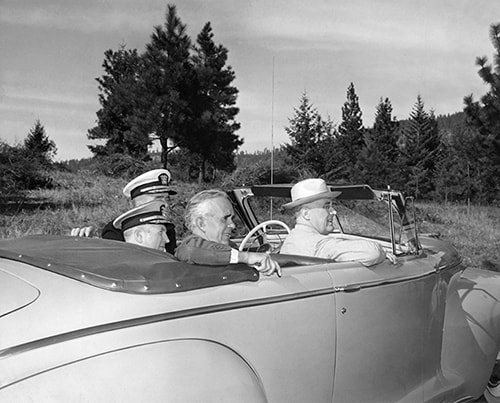 The original photo showing FDR in the front seat, and Idaho Governor Chase Clark in back with a couple of Navy officials.
The original photo showing FDR in the front seat, and Idaho Governor Chase Clark in back with a couple of Navy officials.  A blowup of the photo shows that someone removed a cigarette and probably a hearing aid.
A blowup of the photo shows that someone removed a cigarette and probably a hearing aid.
The two workmen looked up as a car went by.
Said one:
‘That almost looks like F.D.R. himself.’
Answered the other:
‘Yep, but he’s at the White House.’
They went back to work.”
It was FDR. He was on a secret nationwide tour of defense plants and military installations. The press was ordered not to cover his trip until two weeks after it was over. His stop in North Idaho took place on September 21, 1942.
The president’s relationship with the press during that time of war has received much analysis in later days. For one thing, the press seemed to shy away from any reference or photograph that might show FDR as anything less than at the top of his game. Pictures of him using a cane were rare. Even rarer were pictures of him in a wheelchair.
John Wood, well known for his history of railroads in the Coeur d’Alene mining area, shared with me a press photo of FDR on his visit to Farragut. He was going to PhotoShop out a few scratches, but when he looked closely at the picture he noticed someone had beaten him to it on the original. That is, the photo was altered in some interesting ways. First, someone seems to have dodged out a cigarette from FDR’s mouth. John also noticed that something was going on with the car’s visor on the right. It looks like there was a map clipped to it, most of which has been retouched to oblivion. When I looked at the photo I noticed one more little history-altering touch. Someone obliterated a hearing aid from FDR’s ear. In a way, it’s the most obvious alteration because it leaves a hearing-aid-shaped void.
For history buffs, this is interesting because it further illuminates to what extent the president’s public image was manipulated. To me the human frailties everyone was hiding only further emphasize the strengths FDR had.
 The original photo showing FDR in the front seat, and Idaho Governor Chase Clark in back with a couple of Navy officials.
The original photo showing FDR in the front seat, and Idaho Governor Chase Clark in back with a couple of Navy officials.  A blowup of the photo shows that someone removed a cigarette and probably a hearing aid.
A blowup of the photo shows that someone removed a cigarette and probably a hearing aid.
Published on June 26, 2019 04:00
June 25, 2019
How Low Can You Go?
Humans, silly things, love owning something that is rare. When it comes to license plates, low numbers are in high demand by collectors. The number 1 is particularly sought after. In Massachusetts, low number plates are in such demand that they hold a lottery for them. The governor of Illinois got in hot water in 2003 for passing out low-numbered plates to political cronies. That who-you-know aspect of low-numbered plates has been common in many jurisdictions, leading to the belief by some that police would tend to let drivers with low-numbered plates slide on minor traffic infractions. Who would want to ruffle the feathers of some VIP?
There could be a little truth to that. Certain VIPs get special plates. Governors in Idaho started getting their own number 1 plates back in 1957.
In 1977, Idaho State Trooper Rich Wills pulled over a car going 61 in a 35-mph construction zone. When he hit the lights, he hadn’t noticed that the license plate had only the numeral 1 on it. Yes, it was the governor. Governor John Evans wasn’t driving. His press secretary, Steve Leroy, was. Leroy was pushing the speed limit a tad in order to get the governor to a speech on time. Trooper Wills gave Leroy a quick lecture about slowing down and sent the men on their way.
Wills got a little grief in the press over the incident. It hardly ruined his life, though. He spent years with the state police before becoming a state representative. He now serves on the Idaho Commission of Pardons and Paroles.
But, what’s so special about low-numbered plates? The number 1 is no rarer than the number 3315, when it comes to plates. Humans. Silly things.
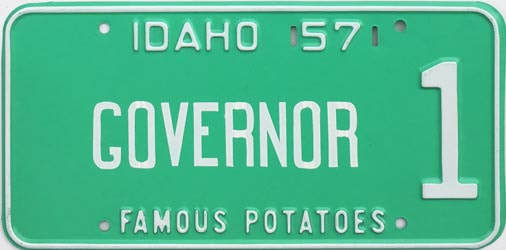
There could be a little truth to that. Certain VIPs get special plates. Governors in Idaho started getting their own number 1 plates back in 1957.
In 1977, Idaho State Trooper Rich Wills pulled over a car going 61 in a 35-mph construction zone. When he hit the lights, he hadn’t noticed that the license plate had only the numeral 1 on it. Yes, it was the governor. Governor John Evans wasn’t driving. His press secretary, Steve Leroy, was. Leroy was pushing the speed limit a tad in order to get the governor to a speech on time. Trooper Wills gave Leroy a quick lecture about slowing down and sent the men on their way.
Wills got a little grief in the press over the incident. It hardly ruined his life, though. He spent years with the state police before becoming a state representative. He now serves on the Idaho Commission of Pardons and Paroles.
But, what’s so special about low-numbered plates? The number 1 is no rarer than the number 3315, when it comes to plates. Humans. Silly things.

Published on June 25, 2019 04:00
June 24, 2019
Giving the Statehouse Wings
The Idaho capitol couldn’t fly until it had wings. Old pictures of the statehouse with its familiar dome, spreading stairs, and soaring columns, sans the senate and house wings make the whole thing look a little stubby. The east and west additions balanced the look of the building and made it much more functional.
Adding the wings wasn’t as easy as it might seem. First, Legislators had to haggle over an appropriations bill. That gave members from eastern Idaho an excuse to bring up the idea of moving the capital halfway across the state, specifically to Shoshone. They thought the existing building would make a fine university. The idea did not have wings.
Once $900,000 was appropriated for construction of the additions, there was the matter of the state not actually owning the property where they were to go. Boiseans were asked to pass a bond of $135,000 to purchase the property where the wings would be built (see photo announcing a town meeting about it). The newly acquired property would later be swapped with the state.
Once the Boise bond was passed, the structures on the property had to go away. They included the Central School building, which was being used at the time by the state agriculture department. The Sherman House, a fashionable boarding house once owned by the sister of Mary Hallock Foote would come down, as would Collister Flats, the Aloha Apartments, and four small residences.
The wings, which now host the chambers of the house and senate as well as other state offices, were completed in 1920.
The statehouse before it got its wings, courtesy of the Idaho State Historical Society digital collection.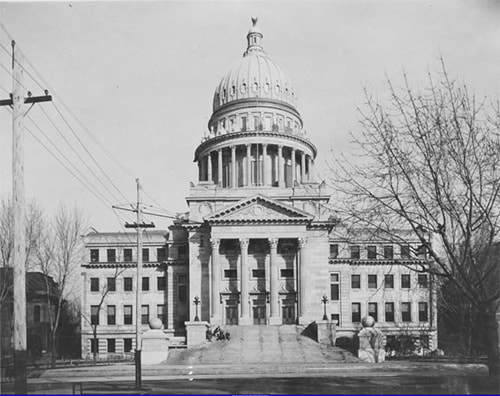
Adding the wings wasn’t as easy as it might seem. First, Legislators had to haggle over an appropriations bill. That gave members from eastern Idaho an excuse to bring up the idea of moving the capital halfway across the state, specifically to Shoshone. They thought the existing building would make a fine university. The idea did not have wings.
Once $900,000 was appropriated for construction of the additions, there was the matter of the state not actually owning the property where they were to go. Boiseans were asked to pass a bond of $135,000 to purchase the property where the wings would be built (see photo announcing a town meeting about it). The newly acquired property would later be swapped with the state.
Once the Boise bond was passed, the structures on the property had to go away. They included the Central School building, which was being used at the time by the state agriculture department. The Sherman House, a fashionable boarding house once owned by the sister of Mary Hallock Foote would come down, as would Collister Flats, the Aloha Apartments, and four small residences.
The wings, which now host the chambers of the house and senate as well as other state offices, were completed in 1920.
The statehouse before it got its wings, courtesy of the Idaho State Historical Society digital collection.

Published on June 24, 2019 04:00
June 23, 2019
Where do I Register?
How much should we trust early paintings of the West? Artists take their license. Even photographers frame their images to show what they want to show.
The question comes up because I recently ran across Fredric Remington’s painting titled Register Rock, a photo of which is shown below. Remington painted many iconic scenes of the West. They captured a sense of place like few other works of art. Yet, this depiction of Register Rock, described as a “twenty-foot-high boulder” in the book One Hundred Years of Idaho Art, 1850-1950 , resembles the actual rock very little.
There are two Register Rocks in Idaho. The one on the Oregon Trail is located near the Snake River and is a part of Massacre Rocks State Park. It has its own interstate exit. The rock is closer to 10 feet high than 20, and it doesn’t look as if it’s aspiring to be a spire, as the one in the painting does. The real rock is a more or less round, featureless boulder, much like a dozen others of its size in the park. It’s also black. The only thing that sets it apart is that someone travelling the Oregon Trail decided to carve their name and a date on its surface, starting a tradition that other travelers followed.
Remington likely sketched the rock and the surrounding scenery and took the sketch back to a studio to paint. It was painted in 1891. The painter was known for his realism, so why doesn’t the rock look like the rock?
Remington may have given it a more dramatic shape for the… drama. Or, maybe this is a painting of the other Register Rock, the one near the Utah border in City of Rocks National Reserve. There pioneers on the California Trail left their names on the rock in axle grease. It looks much more like the rock depicted in the painting, though not decisively so. The coloration is closer.
The names on both rocks have been documented, so it would seem a simple thing to just read a few from the painting and determine which rock Remington was depicting. Au contraire. The writing on the Remington piece is just representative, squiggles that look like names from a distance. Close up, they are still just squiggles.
So which register rock is it, where do we register a complaint?
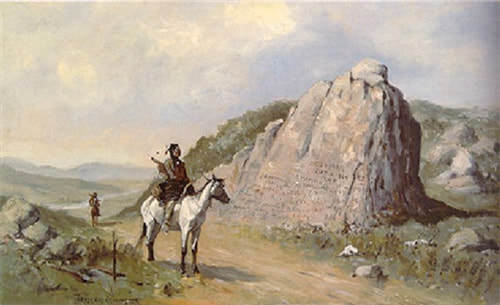
The question comes up because I recently ran across Fredric Remington’s painting titled Register Rock, a photo of which is shown below. Remington painted many iconic scenes of the West. They captured a sense of place like few other works of art. Yet, this depiction of Register Rock, described as a “twenty-foot-high boulder” in the book One Hundred Years of Idaho Art, 1850-1950 , resembles the actual rock very little.
There are two Register Rocks in Idaho. The one on the Oregon Trail is located near the Snake River and is a part of Massacre Rocks State Park. It has its own interstate exit. The rock is closer to 10 feet high than 20, and it doesn’t look as if it’s aspiring to be a spire, as the one in the painting does. The real rock is a more or less round, featureless boulder, much like a dozen others of its size in the park. It’s also black. The only thing that sets it apart is that someone travelling the Oregon Trail decided to carve their name and a date on its surface, starting a tradition that other travelers followed.
Remington likely sketched the rock and the surrounding scenery and took the sketch back to a studio to paint. It was painted in 1891. The painter was known for his realism, so why doesn’t the rock look like the rock?
Remington may have given it a more dramatic shape for the… drama. Or, maybe this is a painting of the other Register Rock, the one near the Utah border in City of Rocks National Reserve. There pioneers on the California Trail left their names on the rock in axle grease. It looks much more like the rock depicted in the painting, though not decisively so. The coloration is closer.
The names on both rocks have been documented, so it would seem a simple thing to just read a few from the painting and determine which rock Remington was depicting. Au contraire. The writing on the Remington piece is just representative, squiggles that look like names from a distance. Close up, they are still just squiggles.
So which register rock is it, where do we register a complaint?

Published on June 23, 2019 04:00
June 22, 2019
Beyond Hope
Residents of Hope, Idaho, take note. Here’s another of the endless opportunities to play on the name of your town by declaring that something is beyond Hope. In this case, someONE was beyond.
Hope was named in 1882 for a Doctor Hope who was a veterinarian with the Northern Pacific Railroad. But this is a beyond hope story.
It seems that a barber showed up in Sandpoint and worked in a barbershop there for a few days. He was reportedly a handsome, clean-shaven man with graying auburn hair who might have come from Kansas City.
None of that would have made the papers. His last act, did. The Spokesman Review reported that “he came to Hope Thursday evening showing signs of having been under the influence of liquor. During the evening, he flourished a razor in a hotel office and told the night clerk he would prove to the people present that he was a nervy man by cutting his own throat.”
The clerk talked quietly to the man and persuaded him to put the razor away.
But early the next morning the man was back. Quoting the paper, “at 5:30 he walked out onto the platform and five minutes later drew the razor from his breast pocket with his right hand, pulled down his shirt collar with the left hand, threw his head back and a little to one side, then drew the blade across his jugular and cut an awful gash in his throat.”
After that the report gets graphic. Suffice to say the man spent a minute or two dying. No clue about who he was could be found among his effects.
The paper dutifully reported that the coroner ruled the death a suicide.
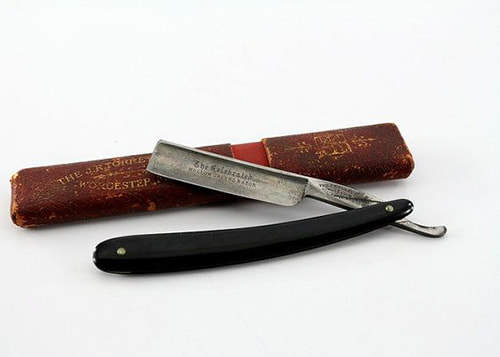
Hope was named in 1882 for a Doctor Hope who was a veterinarian with the Northern Pacific Railroad. But this is a beyond hope story.
It seems that a barber showed up in Sandpoint and worked in a barbershop there for a few days. He was reportedly a handsome, clean-shaven man with graying auburn hair who might have come from Kansas City.
None of that would have made the papers. His last act, did. The Spokesman Review reported that “he came to Hope Thursday evening showing signs of having been under the influence of liquor. During the evening, he flourished a razor in a hotel office and told the night clerk he would prove to the people present that he was a nervy man by cutting his own throat.”
The clerk talked quietly to the man and persuaded him to put the razor away.
But early the next morning the man was back. Quoting the paper, “at 5:30 he walked out onto the platform and five minutes later drew the razor from his breast pocket with his right hand, pulled down his shirt collar with the left hand, threw his head back and a little to one side, then drew the blade across his jugular and cut an awful gash in his throat.”
After that the report gets graphic. Suffice to say the man spent a minute or two dying. No clue about who he was could be found among his effects.
The paper dutifully reported that the coroner ruled the death a suicide.

Published on June 22, 2019 04:00
June 21, 2019
Flying Beaver
I ran across the picture below at a new display at the Idaho State Archives on outdoor recreation in Idaho. The photo shows an interpretive display about the Idaho Department of Fish and Game’s parachuting beaver project that started in 1948. This program became a YouTube sensation a couple of years ago when someone found an old newsreel-like film about the flying beavers. It was a hit because the project sounds a little goofy, and the narrator is, well, a 1940s narrator. You have to hear it to appreciate it.
The sign in the photo is probably too small in this reproduction to read, but it says that more than 600 beaver would be dropped that year and that 50 had already been dropped in the Chamberlain Basin, northeast of McCall and in the Lochsa-Selway area.
The crates, each containing one 80-100 pound beaver, were dropped in pairs, one male, one female, so that courtship could begin soon after the wooden containers opened on impact. Using cargo chutes, which would later be retrieved by employees hiking into the back country, the beaver boxes were dropped from about 600 feet.
This might seem a silly effort, but it was successful in getting more beavers into areas where they were needed. Yes, needed. Tens of thousands of beavers were taken for their fur in the 19th century, and trapping continues today on a smaller scale. The rodents can change the character of an area faster than anything, save fire. They create terrific habitat for dozens of species.
Beavers rarely fly, the previous example being the exception. They are the largest rodent in North America and the second largest in the world, edged out by South America’s capybara.
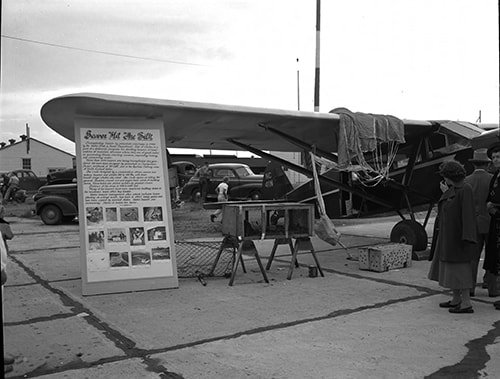
The sign in the photo is probably too small in this reproduction to read, but it says that more than 600 beaver would be dropped that year and that 50 had already been dropped in the Chamberlain Basin, northeast of McCall and in the Lochsa-Selway area.
The crates, each containing one 80-100 pound beaver, were dropped in pairs, one male, one female, so that courtship could begin soon after the wooden containers opened on impact. Using cargo chutes, which would later be retrieved by employees hiking into the back country, the beaver boxes were dropped from about 600 feet.
This might seem a silly effort, but it was successful in getting more beavers into areas where they were needed. Yes, needed. Tens of thousands of beavers were taken for their fur in the 19th century, and trapping continues today on a smaller scale. The rodents can change the character of an area faster than anything, save fire. They create terrific habitat for dozens of species.
Beavers rarely fly, the previous example being the exception. They are the largest rodent in North America and the second largest in the world, edged out by South America’s capybara.

Published on June 21, 2019 04:00
June 20, 2019
Basque Boarding Houses
Assimilating into a new country and culture is not something that is done overnight. The Basques had some unique ways of coping with the stress of immigration.
You may think of Basques as sheepherders because in this country they often were. For most of them it wasn’t a way of life they had known in the Old Country. It was simply a job that they could learn quickly and one that didn’t require them to take on a new language immediately. The sheep didn’t care what language they spoke.
With themselves for company Basque Sheepherders got along fine during the warm months of the year. But what to do come winter? Their solution was to come together in Basque boarding houses where they could speak the language they knew, eat familiar food, and socialize with their own people. At the same time, the boarding houses were in towns where English was common and they could learn more about their adopted country.
During much of the Twentieth Century you could find Basque boarding houses, or ostatuak, in Boise, Caldwell, Cascade, Emmett, Gooding, Hailey, Jerome, Mackay, Mountain Home, Mullan, Nampa, Pocatelo, Rupert, Shoshone, and Twin Falls. There were more than 50 of them in Boise, alone, including one at the city’s oldest standing brick building, the Jacobs-Uberuaga House (photo), built in 1864. It became a Basque boarding house in 1910. The house is now the physical and historical center of Boise’s Basque Block.
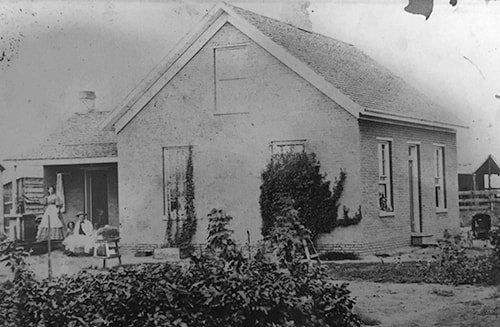
You may think of Basques as sheepherders because in this country they often were. For most of them it wasn’t a way of life they had known in the Old Country. It was simply a job that they could learn quickly and one that didn’t require them to take on a new language immediately. The sheep didn’t care what language they spoke.
With themselves for company Basque Sheepherders got along fine during the warm months of the year. But what to do come winter? Their solution was to come together in Basque boarding houses where they could speak the language they knew, eat familiar food, and socialize with their own people. At the same time, the boarding houses were in towns where English was common and they could learn more about their adopted country.
During much of the Twentieth Century you could find Basque boarding houses, or ostatuak, in Boise, Caldwell, Cascade, Emmett, Gooding, Hailey, Jerome, Mackay, Mountain Home, Mullan, Nampa, Pocatelo, Rupert, Shoshone, and Twin Falls. There were more than 50 of them in Boise, alone, including one at the city’s oldest standing brick building, the Jacobs-Uberuaga House (photo), built in 1864. It became a Basque boarding house in 1910. The house is now the physical and historical center of Boise’s Basque Block.

Published on June 20, 2019 05:17
What's so Valuable Behind those Doors?
There are many beautiful doors in Idaho’s statehouse. Most are wooden, many with glass or frosted glass windows in the upper half. Two, though, are unique. To enter certain offices in the Idaho Capitol, you step through the openings of door-sized safes. The gleaming steel doors with hefty metal latches, knurled knobs, and gold-leaf lettering once protected the state’s treasury back when physical money from tax revenues was kept there before finding its way to the bank.
There is little need for enormous vaults to protect cash anymore, but when the renovated statehouse was reopened to the public in 2010 we found that those historical doors—minor treasures in themselves—had been retained.

There is little need for enormous vaults to protect cash anymore, but when the renovated statehouse was reopened to the public in 2010 we found that those historical doors—minor treasures in themselves—had been retained.

Published on June 20, 2019 02:08



